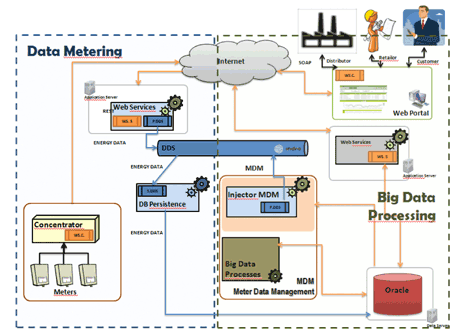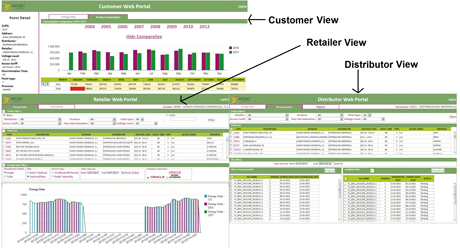by Agustín Yagüe, Juan Garbajosa and Mercedes Lopez-Perea
The electric power distribution and commercialization scenario is evolving worldwide, and electricity companies, faced with the challenge of new information requirements, are demanding IT solutions to deal with the smart monitoring of power networks. Two main challenges arise from data management and smart monitoring of power networks: real-time data acquisition and big data processing over short time periods. We present a solution in the form of a system architecture that conveys real time issues and has the capacity for big data management.
Electric power distribution markets worldwide are evolving, and power companies are demanding solutions that help them manage real time problems more efficiently and safely, whilst facilitating the integration of real time information into all corporate applications. These requirements present new data management challenges, which must be addressed by smart grids [1] with their capacity for smart metering and real time monitoring [2]. Smart grid management requires dealing with huge amounts of data including data collected from smart meters and other devices connected to the power network. The enormous volume of data scales up the data management to a Big Data issue [3]. Currently, data are acquired from meters throughout the day, and analysed “off-line” in time-constrained periods (quarterly, hourly, daily and monthly). Consequently, electricity companies are demanding IT solutions to deal with the smart monitoring of power networks and, in turn, to be able to respond to the current market energy needs in real time. However, there are two main challenges behind the smart monitoring of power networks: real-time data acquisition and big data processing in a short period time. We present a solution: a system architecture that conveys real time issues and has the capacity for big data management.
The company Indra Software Labs (ISL) and the research group SYstems and Software Technology (SYST) of the Technical University of Madrid (UPM) are working in close collaboration on the ITEA2 project IMPONET to deal with these challenges. IMPONET has developed a flexible platform that allows the continuous monitoring of the network with real time or quasi real time data processing and the configuration of the customer consumption profile to monitor its evolution and to make decisions based on its information.
The IMPONET platform includes components/modules for the remote control and smart metering of distributed energy sources and mobile energy consumption (eg electric vehicles) by using smart devices and following the Service-Oriented Architecture (SOA) approach. To provide this functionality, these components/modules have the capacity to respond in real time to the massive amounts of information that will be received from the network and to store them, as well as the signals that will have to be transmitted to the devices in the field.

Figure 1: IMPONET Data Management Platform
The data metering is achieved with a powerful communication bus based on the standard data distribution service (DDS), a real-time publish-subscribe paradigm, and the storage of information into a real-time database (see Figure 1). The DDS bus serves as a coordinator for the rest of the components/modules of the platform to guarantee the real-time capability. The big data processing has to be performed in such a way that the massive amounts of information extracted from smart meters can be processed on time (see Figure 1). Big data processing has been addressed by using Hadoop and Oracle Berkeley DB Non-SQL database. Hadoop Map-Reduce provides parallel and distributed data processing with Non-SQL approach. This implementation has been validated through different smart grid scenarios obtaining the promising results of storing and processing around 150 M measures in less than three hours.

Figure 2: IMPONET Web Portal: distributor, retailer and customer views
The information processing involves handling raw data to obtain optimal data by performing two operations: (i) validation of meter data according to an established validation formula, (ii) calculation of the best available energy data from different sources for a measuring point, magnitude and period of energy data. This information is then provided to the customer, the retailer and the distributor from different perspectives, enabling different stakeholders to analyse the results from their own particular point of view (see Figure 2).
Link:
IMPONET: Intelligent Monitoring of POwer NETworks: http://www.innovationenergy.org/imponet/
References:
[1] S. Massoud and B.F. Wollenberg: “Toward a Smart Grid”, IEEE P&E Magazine 3(5), 2005
[2] J. Byun et al: “A smart energy distribution and management system for renewable energy distribution and context-aware services based on user patterns and load forecasting”, IEEE Transactions on Consumer Electronics, vol. 57 , nº.2, 2011
[3] S. Madden: “From Databases to Big Data”, IEEE Internet Computing, vol.16 nº.3, 2012.
Please contact:
Catherine Murphy Oconnor
Indra Software Labs, Spain
Tel: +34 914806774
E-mail:











